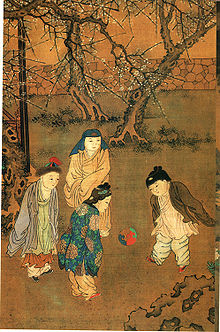Kemari

Kemari (蹴鞠) is an athletic game that was popular in Japan during the Heian (794–1185) and Kamakura period (1185–1333). It resembles a game of keepie uppie or hacky sack. The game was popular in Kyoto, the capital, and the surrounding Kinki (Kansai region), and over time it spread from the aristocracy to the samurai class and chōnin class. Nowadays, kemari is played as a seasonal event mainly at Shinto shrines in the Kansai region, and players play in a costume called kariginu (ja:狩衣), which was worn as everyday clothing by court nobles during the Heian period.[1]
History
[edit]


The earliest kemari was created under the influence of the Chinese sport cuju, which has the same kanji.[2] It is often said that the earliest evidence of kemari is the record of 644 CE in the Nihon Shoki,[3] but this theory is disputed. In 644, Prince Naka-no-Ōe and Nakatomi no Kamatari, who later initiated the Taika Reforms, became friends during a ball game described as "打鞠", but it may have been a hockey-like ball game using a cane instead of kemari. The earliest reliable documentary evidence of the word kemari (蹴鞠) is found in a record of an annual event called Honchō gatsuryo (ja:本朝月令) written in the middle of the Heian period. According to the records, a kemari games were played in May 701.[1]
Kemari became popular as a game for the nobility in the late Heian period (794–1185) in the 11th century, and in the 12th century, Fujiwara no Narimichi (ja:藤原成通) and Nanba Yorisuke (ja:難波頼輔) gained fame as masters of kemari. Fujiwara no Narimichi had made more than 50 visits to the Kumano Hongū Taisha to pray that his kemari skills would improve, and he had performed the kemari feat known as a ushiro mari (後ろ鞠, backward ball) in front of the shrine where Susanoo was enshrined. This technique is a keepie uppie performed on the heel.[1]
It reached its peak between the end of the 12th century and around the 13th century in the early Kamakura period (1185–1333), and kemari games were often played during the reign of Minamoto no Yoriie. This led to the establishment of a variety of new rules, equipment and techniques, and the completion of a structured art form called kemaridō (蹴鞠道). In the Kamakura period, kemari became popular among the samurai class, and in the Muromachi period (1336–1573), kemari, along with various other performing arts such as waka (Japanese poetry) and the Japanese tea ceremony, was regarded as one of the art forms that the samurai class was encouraged to master.[1][4]

In the Sengoku period (1467–1615), sumo became popular and kemari declined, but in the Edo period (1683–1868) it became popular again as a game played by chōnin class in the Kinai (Kansai region).[1]
In the past, aristocrats living in Kyoto used to play kemari as an annual event on New Year's Day, January 4. Emperor Meiji feared that the rapid modernization of Japan would lead to the loss of various traditional Japanese cultures, and in 1903, an association was established to preserve kemari by contributing an imperial grant. Today, kemari is performed as a seasonal event in Shinto shrines around the Kansai region such as Shimogamo Shrine, Shiramine Jingū, Fujimori Shrine (ja:藤森神社), Tanzan Shrine, Hirano Shrine and Kotohira-gū. Seidaimyōjin (精大明神), enshrined as one of the sessha (auxiliary shrine) of Shiramine Shrine, is the kami of the mari (kemari ball) and is therefore respected by players of various ball games, mainly association football.[1]
George H. W. Bush played the game on one of his presidential visits to Japan.[5][6]
Description
[edit]It is a non-competitive sport.[7] The object of Kemari is to keep one ball in the air,[2] with all players cooperating to do so. Players may use any body part with the exception of arms and hands: their head, feet, knees, back, and depending on the rules, elbows to keep the ball aloft. The ball, known as a mari, is made of deerskin with the hair facing inside and the hide on the outside. The ball is stuffed with barley grains to give it shape. When the hide has set in this shape, the grains are removed from the ball, and it is then sewn together using the skin of a horse. The one who kicks the ball is called a mariashi. A good mariashi makes it easy for the receiver to control the mari, and serves it with a soft touch to make it easy to keep the mari in the air.
Kemari is played on a flat ground, about 6–7 meters squared.[3] The uniforms that the modern players wear are reminiscent of the clothes of the Heian period and include a crow hat. This type of clothing was called kariginu (ja:狩衣) and it was fashionable at that time.
See also
[edit]References
[edit]- ^ a b c d e f 神社と深くつながる「蹴鞠」 (in Japanese). Kokugakuin University. Archived from the original on 5 December 2022. Retrieved 5 December 2022.
- ^ a b Witzig, Richard (2006). The Global Art of Soccer. CusiBoy Publishing. p. 5. ISBN 9780977668809. Retrieved 2010-07-08.
- ^ a b Allen Guttmann, Lee Austin Thompson (2001). Japanese sports: a history. University of Hawaii Press. pp. 26–27. ISBN 9780824824648. Retrieved 2010-07-08.
- ^ 蹴鞠 (in Japanese). Kotobank/Digitalio, Inc/Asahi Shimbun. Archived from the original on 5 December 2022. Retrieved 5 December 2022.
- ^ Wines, Michael (1992-01-07). "On Japan Leg of Journey, Bush's Stakes Are High". The New York Times.
- ^ Wines, Michael (1992-01-08). "Japanese Visit, on the Surface: Jovial Bush, Friendly Crowds". The New York Times.
- ^ "History of Football". FIFA. Archived from the original on December 25, 2012. Retrieved 29 April 2013.
External links
[edit]![]() Media related to Kemari at Wikimedia Commons
Media related to Kemari at Wikimedia Commons

